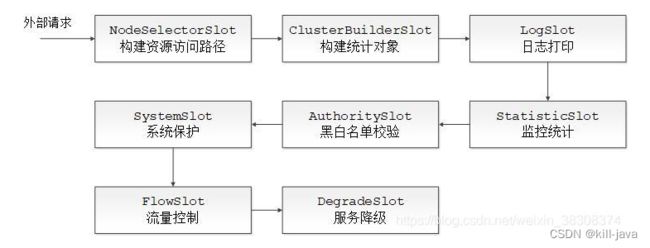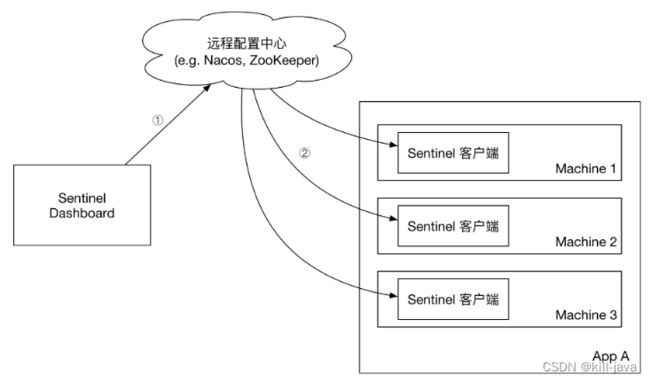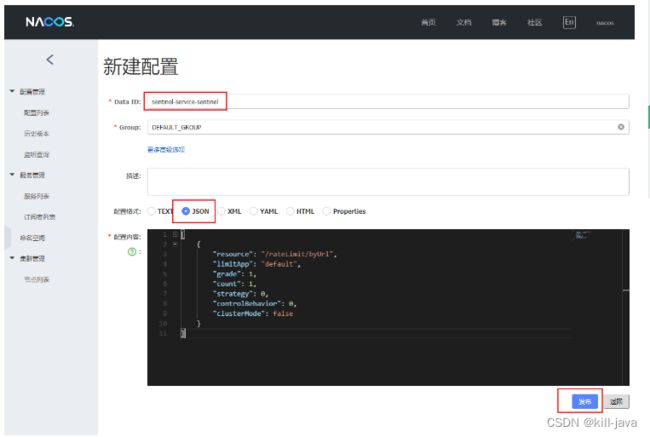springcloud基于Sentinel的熔断与限流快速实践
Sentinel简介
- 随着微服务的流行,服务和服务之间的稳定性变得越来越重要。 Sentinel 以流量为切入点,从流量控制、熔断降级、系统负载保护等多个维度保护服务的稳定性。
- Sentinel具有如下特性:
- 丰富的应用场景:承接了阿里巴巴近 10 年的双十一大促流量的核心场景,例如秒杀,可以实时熔断下游不可用应用;
- 完备的实时监控:同时提供实时的监控功能。可以在控制台中看到接入应用的单台机器秒级数据,甚至 500 台以下规模的集群的汇总运行情况;
- 广泛的开源生态:提供开箱即用的与其它开源框架/库的整合模块,例如与 Spring Cloud、Dubbo、gRPC 的整合;
- 完善的 SPI 扩展点:提供简单易用、完善的 SPI 扩展点。您可以通过实现扩展点,快速的定制逻辑。
基本原理
- sentinel在内部创建了一个责任链
- 责任链是由一系列ProcessorSlot对象组成的
- 每个ProcessorSlot对象负责不同的功能,外部请求是否允许访问资源,需要通过责任链的校验,只有校验通过的,才可以访问资源
- 如果被校验失败,会抛出BlockException异常。
- sentinel提供了8个ProcessorSlot的实现类,下面实现类功能介绍:
- DegradeSlot:用于服务降级,如果发现服务超时次数或者报错次数超过限制,DegradeSlot将禁止再次访问服务,等待一段时间后,DegradeSlot试探性的放过一个请求,然后根据该请求的处理情况,决定是否再次降级。
- AuthoritySlot:黑白名单校验,按照字符串匹配,如果在黑名单,则禁止访问。
- ClusterBuilderSlot:构建ClusterNode对象,该对象用于统计访问资源的QPS、线程数、异常、响应时间等,每个资源对应一个ClusterNode对象。
- SystemSlot:校验QPS、并发线程数、系统负载、CPU使用率、平均响应时间是否超过限制,使用滑动窗口算法统计上述这些数据。
- StatisticSlot:用于从多个维度(入口流量、调用者、当前被访问资源)统计响应时间、并发线程数、处理失败个数、处理成功个数等。
- FlowSlot:用于流控,可以根据QPS或者每秒并发线程数控制,当QPS或者并发线程数超过设定值,便会抛出FlowException异常。FlowSlot依赖于StatisticSlot的统计数据。
- NodeSelectorSlot:负责收集资源路径,并将这些资源的调用路径,以树状结构存储起来,用于根据调用路径来限流降级、数据统计。
- LogSlot:打印日志。
- SphU是Alibaba Sentinel流控的入口类,用于对资源的访问控制, 简单使用如下
@Test
public void requestTest() {
// Entry就是一个资源操作对象
Entry entry = null;
try {
//对资源(resource)进行检查,如果流控则抛出BlockedException
//"resource"一般是请求路径或有SentinelResource注解类定义的访问资源
entry = SphU.entry("resource");
//走到这里,表示没有被流控,可以执行相关业务代码
} catch (BlockException e) {
// 如果没有通过走到了这里,就表示请求被限流,这里进行降级操作
e.printStackTrace();
}finally {
if(null != entry){
entry.close();
}
}
- 入口:SphU.entry() 。这个方法会去申请一个entry,如果能够申请成功,则说明没有被限流,否则会抛出BlockException,表面已经被限流了。
- 从 SphU.entry() 方法往下执行会进入到 Sph.entry() ,Sph的默认实现类是 CtSph ,在CtSph中最终会执行到 entry(ResourceWrapper resourceWrapper, int count, Object… args) throws BlockException 这个方法。
- 这个方法可以分为以下几个部分:
- 对参数和全局配置项做检测,如果不符合要求就直接返回了一个CtEntry对象,不会再进行后面的限流检测,否则进入下面的检测流程。
- 根据包装过的资源对象获取对应的SlotChain
- 执行SlotChain的entry方法
- 如果SlotChain的entry方法抛出了BlockException,则将该异常继续向上抛出
- 如果SlotChain的entry方法正常执行了,则最后会将该entry对象返回
- 如果上层方法捕获了BlockException,则说明请求被限流了,否则请求能正常执行
安装Sentinel控制台
- Sentinel控制台是一个轻量级的控制台应用,它可用于实时查看单机资源监控及集群资源汇总,并提供了一系列的规则管理功能,如流控规则、降级规则、热点规则等。
- 我们先从官网下载Sentinel,这里下载的是sentinel-dashboard-1.6.3.jar文件,下载地址:https://github.com/alibaba/Sentinel/releases
- 下载完成后在命令行输入如下命令运行Sentinel控制台:
java -jar sentinel-dashboard-1.6.3.jar
- Sentinel控制台默认运行在8080端口上,登录账号密码均为sentinel,通过如下地址可以进行访问:http://localhost:8080

- Sentinel控制台可以查看单台机器的实时监控数据。
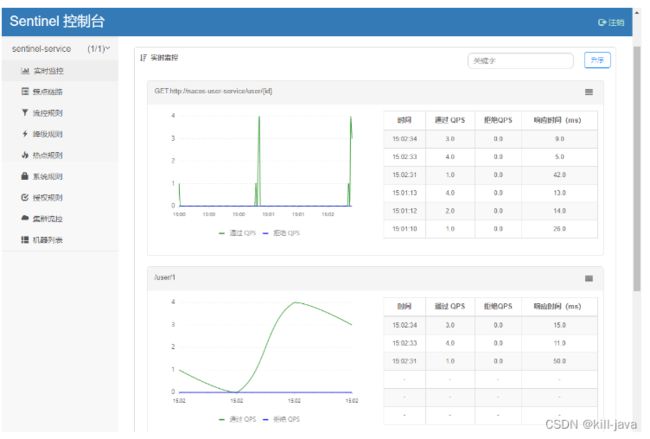
Java实现sentinel
- 创建sentinel-service模块
- 在pom.xml中添加相关依赖,这里我们使用Nacos作为注册中心,所以需要同时添加Nacos的依赖:
<dependency>
<groupId>com.alibaba.cloud</groupId>
<artifactId>spring-cloud-starter-alibaba-nacos-discovery</artifactId>
</dependency>
<dependency>
<groupId>com.alibaba.cloud</groupId>
<artifactId>spring-cloud-starter-alibaba-sentinel</artifactId>
</dependency>
- 在application.yml中添加相关配置,主要是配置了Nacos和Sentinel控制台的地址:
server:
port: 8401
spring:
application:
name: sentinel-service
cloud:
nacos:
discovery:
server-addr: localhost:8848 #配置Nacos地址
sentinel:
transport:
dashboard: localhost:8080 #配置sentinel dashboard地址
port: 8719
service-url:
user-service: http://nacos-user-service
management:
endpoints:
web:
exposure:
include: '*'
限流功能
-
Sentinel Starter 默认为所有的 HTTP 服务提供了限流埋点,我们也可以通过使用@SentinelResource来自定义一些限流行为。
-
创建RateLimitController类
- 用于测试熔断和限流功能。
@RestController
@RequestMapping("/rateLimit")
public class RateLimitController {
/**
* 按资源名称限流,需要指定限流处理逻辑
*/
@GetMapping("/byResource")
@SentinelResource(value = "byResource",blockHandler = "handleException")
public CommonResult byResource() {
return new CommonResult("按资源名称限流", 200);
}
/**
* 按URL限流,有默认的限流处理逻辑
*/
@GetMapping("/byUrl")
@SentinelResource(value = "byUrl",blockHandler = "handleException")
public CommonResult byUrl() {
return new CommonResult("按url限流", 200);
}
public CommonResult handleException(BlockException exception){
return new CommonResult(exception.getClass().getCanonicalName(),200);
}
}
根据资源名称限流
- 我们可以根据@SentinelResource注解中定义的value(资源名称)来进行限流操作,但是需要指定限流处理逻辑。
- 流控规则可以在Sentinel控制台进行配置,由于我们使用了Nacos注册中心,我们先启动Nacos和sentinel-service;
- 由于Sentinel采用的懒加载规则,需要我们先访问下接口,Sentinel控制台中才会有对应服务信息,我们先访问下该接口:http://localhost:8401/rateLimit/byResource
- 在Sentinel控制台配置流控规则,根据@SentinelResource注解的value值:
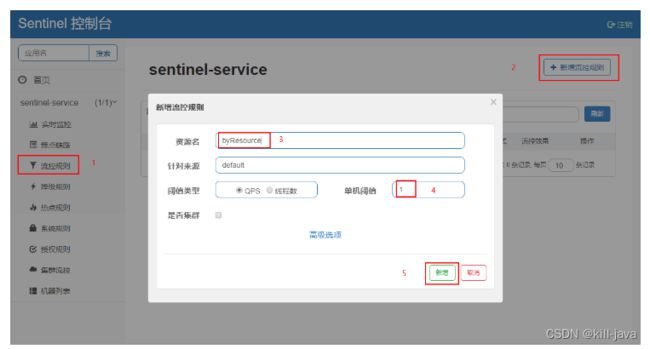
- 快速访问上面的接口,可以发现返回了自己定义的限流处理信息:

根据URL限流
- 我们还可以通过访问的URL来限流,会返回默认的限流处理信息。
- 在Sentinel控制台配置流控规则,使用访问的URL:
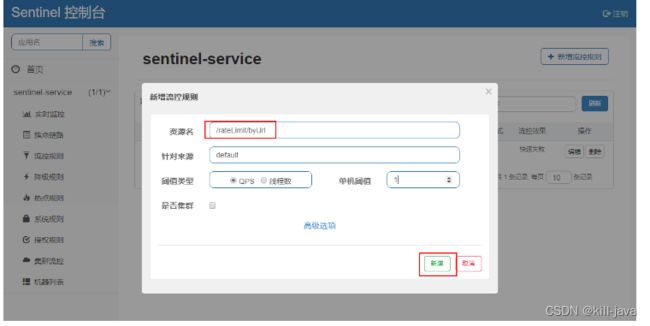
- 多次访问该接口,会返回默认的限流处理结果:http://localhost:8401/rateLimit/byUrl
自定义限流处理逻辑
- 我们可以自定义通用的限流处理逻辑,然后在@SentinelResource中指定。
- 创建CustomBlockHandler类用于自定义限流处理逻辑:
public class CustomBlockHandler {
public CommonResult handleException(BlockException exception){
return new CommonResult("自定义限流信息",200);
}
}
- 在RateLimitController中使用自定义限流处理逻辑:
@RestController
@RequestMapping("/rateLimit")
public class RateLimitController {
/**
* 自定义通用的限流处理逻辑
*/
@GetMapping("/customBlockHandler")
@SentinelResource(value = "customBlockHandler", blockHandler = "handleException",blockHandlerClass = CustomBlockHandler.class)
public CommonResult blockHandler() {
return new CommonResult("限流成功", 200);
}
}
熔断功能
- Sentinel 支持对服务间调用进行保护,对故障应用进行熔断操作,这里我们使用RestTemplate来调用nacos-user-service服务所提供的接口来演示下该功能。
- 首先我们需要使用@SentinelRestTemplate来包装下RestTemplate实例:
@Configuration
public class RibbonConfig {
@Bean
@SentinelRestTemplate
public RestTemplate restTemplate(){
return new RestTemplate();
}
}
- 添加CircleBreakerController类,定义对nacos-user-service提供接口的调用:
@RestController
@RequestMapping("/breaker")
public class CircleBreakerController {
private Logger LOGGER = LoggerFactory.getLogger(CircleBreakerController.class);
@Autowired
private RestTemplate restTemplate;
@Value("${service-url.user-service}")
private String userServiceUrl;
@RequestMapping("/fallback/{id}")
@SentinelResource(value = "fallback",fallback = "handleFallback")
public CommonResult fallback(@PathVariable Long id) {
return restTemplate.getForObject(userServiceUrl + "/user/{1}", CommonResult.class, id);
}
@RequestMapping("/fallbackException/{id}")
@SentinelResource(value = "fallbackException",fallback = "handleFallback2", exceptionsToIgnore = {NullPointerException.class})
public CommonResult fallbackException(@PathVariable Long id) {
if (id == 1) {
throw new IndexOutOfBoundsException();
} else if (id == 2) {
throw new NullPointerException();
}
return restTemplate.getForObject(userServiceUrl + "/user/{1}", CommonResult.class, id);
}
public CommonResult handleFallback(Long id) {
User defaultUser = new User(-1L, "defaultUser", "123456");
return new CommonResult<>(defaultUser,"服务降级返回",200);
}
public CommonResult handleFallback2(@PathVariable Long id, Throwable e) {
LOGGER.error("handleFallback2 id:{},throwable class:{}", id, e.getClass());
User defaultUser = new User(-2L, "defaultUser2", "123456");
return new CommonResult<>(defaultUser,"服务降级返回",200);
}
}
- 启动nacos-user-service和sentinel-service服务:
- 由于我们并没有在nacos-user-service中定义id为4的用户,所有访问如下接口会返回服务降级结果:http://localhost:8401/breaker/fallback/4
{
"data": {
"id": -1,
"username": "defaultUser",
"password": "123456"
},
"message": "服务降级返回",
"code": 200
}
- 由于我们使用了exceptionsToIgnore参数忽略了NullPointerException,所以我们访问接口报空指针时不会发生服务降级:http://localhost:8401/breaker/fallbackException/2

与Feign结合使用
- Sentinel也适配了Feign组件,我们使用Feign来进行服务间调用时,也可以使用它来进行熔断。
- 首先我们需要在pom.xml中添加Feign相关依赖:
<dependency>
<groupId>org.springframework.cloud</groupId>
<artifactId>spring-cloud-starter-openfeign</artifactId>
</dependency>
- 在application.yml中打开Sentinel对Feign的支持:
feign:
sentinel:
enabled: true #打开sentinel对feign的支持
- 在应用启动类上添加@EnableFeignClients启动Feign的功能;
- 创建一个UserService接口,用于定义对nacos-user-service服务的调用:
@FeignClient(value = "nacos-user-service",fallback = UserFallbackService.class)
public interface UserService {
@PostMapping("/user/create")
CommonResult create(@RequestBody User user);
@GetMapping("/user/{id}")
CommonResult<User> getUser(@PathVariable Long id);
@GetMapping("/user/getByUsername")
CommonResult<User> getByUsername(@RequestParam String username);
@PostMapping("/user/update")
CommonResult update(@RequestBody User user);
@PostMapping("/user/delete/{id}")
CommonResult delete(@PathVariable Long id);
}
- 创建UserFallbackService类实现UserService接口,用于处理服务降级逻辑:
@Component
public class UserFallbackService implements UserService {
@Override
public CommonResult create(User user) {
User defaultUser = new User(-1L, "defaultUser", "123456");
return new CommonResult<>(defaultUser,"服务降级返回",200);
}
@Override
public CommonResult<User> getUser(Long id) {
User defaultUser = new User(-1L, "defaultUser", "123456");
return new CommonResult<>(defaultUser,"服务降级返回",200);
}
@Override
public CommonResult<User> getByUsername(String username) {
User defaultUser = new User(-1L, "defaultUser", "123456");
return new CommonResult<>(defaultUser,"服务降级返回",200);
}
@Override
public CommonResult update(User user) {
return new CommonResult("调用失败,服务被降级",500);
}
@Override
public CommonResult delete(Long id) {
return new CommonResult("调用失败,服务被降级",500);
}
}
- 在UserFeignController中使用UserService通过Feign调用nacos-user-service服务中的接口:
@RestController
@RequestMapping("/user")
public class UserFeignController {
@Autowired
private UserService userService;
@GetMapping("/{id}")
public CommonResult getUser(@PathVariable Long id) {
return userService.getUser(id);
}
@GetMapping("/getByUsername")
public CommonResult getByUsername(@RequestParam String username) {
return userService.getByUsername(username);
}
@PostMapping("/create")
public CommonResult create(@RequestBody User user) {
return userService.create(user);
}
@PostMapping("/update")
public CommonResult update(@RequestBody User user) {
return userService.update(user);
}
@PostMapping("/delete/{id}")
public CommonResult delete(@PathVariable Long id) {
return userService.delete(id);
}
}
- 调用如下接口会发生服务降级,返回服务降级处理信息:http://localhost:8401/user/4
{
"data": {
"id": -1,
"username": "defaultUser",
"password": "123456"
},
"message": "服务降级返回",
"code": 200
}
使用Nacos存储规则
- 默认情况下,当我们在Sentinel控制台中配置规则时,控制台推送规则方式是通过API将规则推送至客户端并直接更新到内存中。
- 一旦我们重启应用,规则将消失。下面我们介绍下如何将配置规则进行持久化,以存储到Nacos为例。
原理示意图
- 首先我们直接在配置中心创建规则,配置中心将规则推送到客户端;
- Sentinel控制台也从配置中心去获取配置信息。
功能演示
- 先在pom.xml中添加相关依赖:
<dependency>
<groupId>com.alibaba.csp</groupId>
<artifactId>sentinel-datasource-nacos</artifactId>
</dependency>
- 修改application.yml配置文件,添加Nacos数据源配置:
spring:
cloud:
sentinel:
datasource:
ds1:
nacos:
server-addr: localhost:8848
dataId: ${spring.application.name}-sentinel
groupId: DEFAULT_GROUP
data-type: json
rule-type: flow
- 在Nacos中添加配置:
[
{
"resource": "/rateLimit/byUrl",
"limitApp": "default",
"grade": 1,
"count": 1,
"strategy": 0,
"controlBehavior": 0,
"clusterMode": false
}
]
